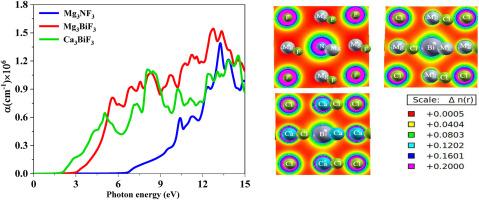Structural, electronic, optical, mechanical, and thermal properties of A3MCl3 (A = Mg, Ca; M = N, Bi) halide perovskites: A first-principles study
IF 3.9
Q3 PHYSICS, CONDENSED MATTER
引用次数: 0
Abstract
The study examines the structural, electronic, optical, mechanical and thermal properties of halide perovskites A3MCl3 (A = Mg, Ca; M = N, Bi) using Density Functional Theory (DFT). The structure was optimized using the Generalized Gradient Approximation – Perdew–Burke–Ernzerhof (GGA-PBE) method, while the electronic and optical properties were calculated using the HSE06 hybrid method. The electronic properties indicate that Mg3NF3 exhibits a wide band gap and behaves as an insulator, while Ca3BiCl3 and Mg3BiCl3 display semiconducting behavior. According to electronic band structure simulations, Mg3NF3 act as insulators, while Mg3BiCl3 and Ca3BiCl3 exhibits semiconductor behavior. Studies of optical properties demonstrate that compounds with Bi absorb strongly within the UV–visible range and reflect very little throughout the spectrum. The compounds show brittle behavior. Mg3NF3 being the stiffest and having the lowest level of anisotropy with wide band gap insulator. According to thermal analysis, Mg3NF3 melts at a high temperature and is a good thermal conductor, which showed promising for applied as heat sink materials. Mg3BiCl3 and Ca3BiCl3 compounds showed low thermal conductivity and are therefore suitable for use in thermal barrier coatings. The combined findings identify A3MCl3 compounds as promising candidates for multifunctional electronic, optoelectronic, photovoltaic, and thermal management devices.

A3MCl3 (A = Mg, Ca; M = N, Bi)卤化物钙钛矿的结构、电子、光学、机械和热性质:第一性原理研究
本研究利用密度泛函理论(DFT)研究了卤化物钙钛矿A3MCl3 (A = Mg, Ca; M = N, Bi)的结构、电子、光学、机械和热性能。采用GGA-PBE (Generalized Gradient Approximation - perdu - burke - ernzerhof)方法对结构进行优化,采用HSE06混合方法计算电子和光学性质。电子性能表明,Mg3NF3具有较宽的带隙和绝缘体特性,而Ca3BiCl3和Mg3BiCl3具有半导体特性。根据电子能带结构模拟,Mg3NF3表现为绝缘体,而Mg3BiCl3和Ca3BiCl3表现为半导体行为。光学性质的研究表明,含有铋的化合物在紫外可见范围内具有很强的吸收,而在整个光谱中反射很小。化合物表现出脆性行为。Mg3NF3是最硬的,各向异性水平最低,具有宽带隙绝缘体。热分析表明,Mg3NF3在高温下熔化,是一种良好的热导体,具有广泛的应用前景。Mg3BiCl3和Ca3BiCl3化合物表现出低导热性,因此适合用于热障涂层。综合研究结果确定A3MCl3化合物是多功能电子,光电,光伏和热管理器件的有希望的候选者。
本文章由计算机程序翻译,如有差异,请以英文原文为准。
求助全文
约1分钟内获得全文
求助全文
来源期刊

Computational Condensed Matter
PHYSICS, CONDENSED MATTER-
CiteScore
3.70
自引率
9.50%
发文量
134
审稿时长
39 days
 求助内容:
求助内容: 应助结果提醒方式:
应助结果提醒方式:


